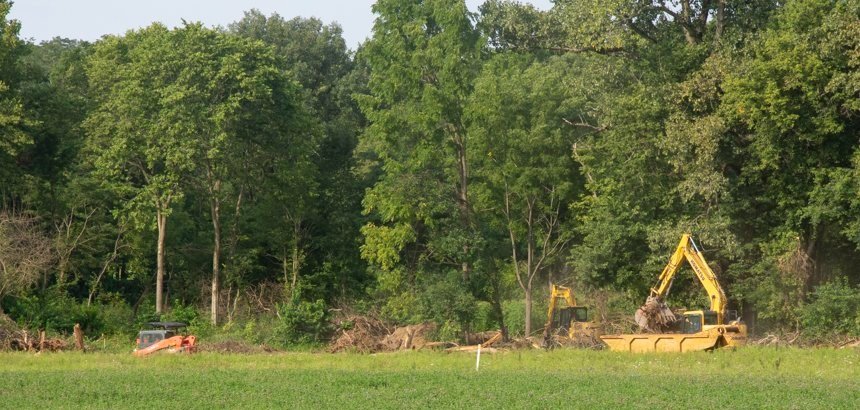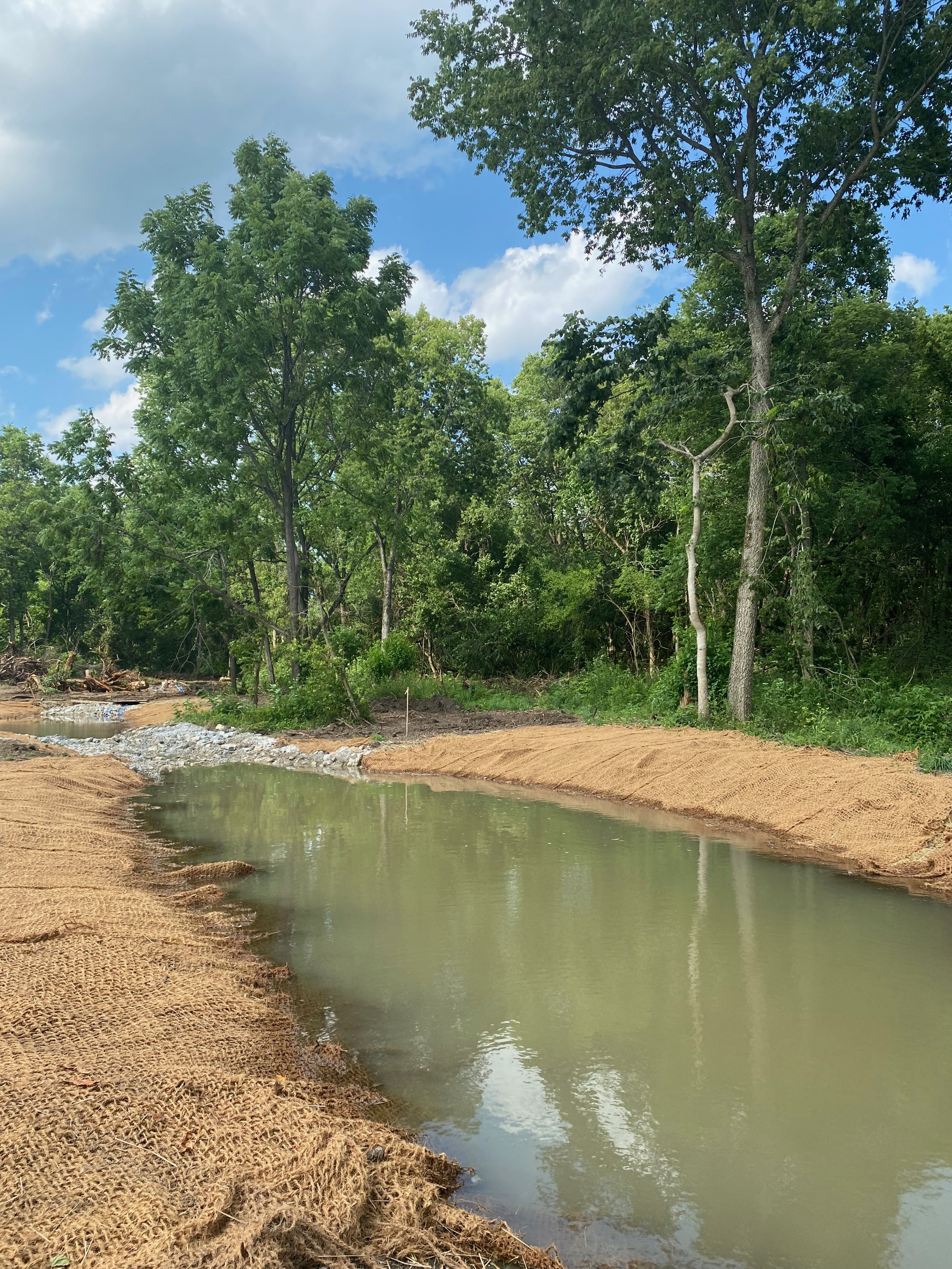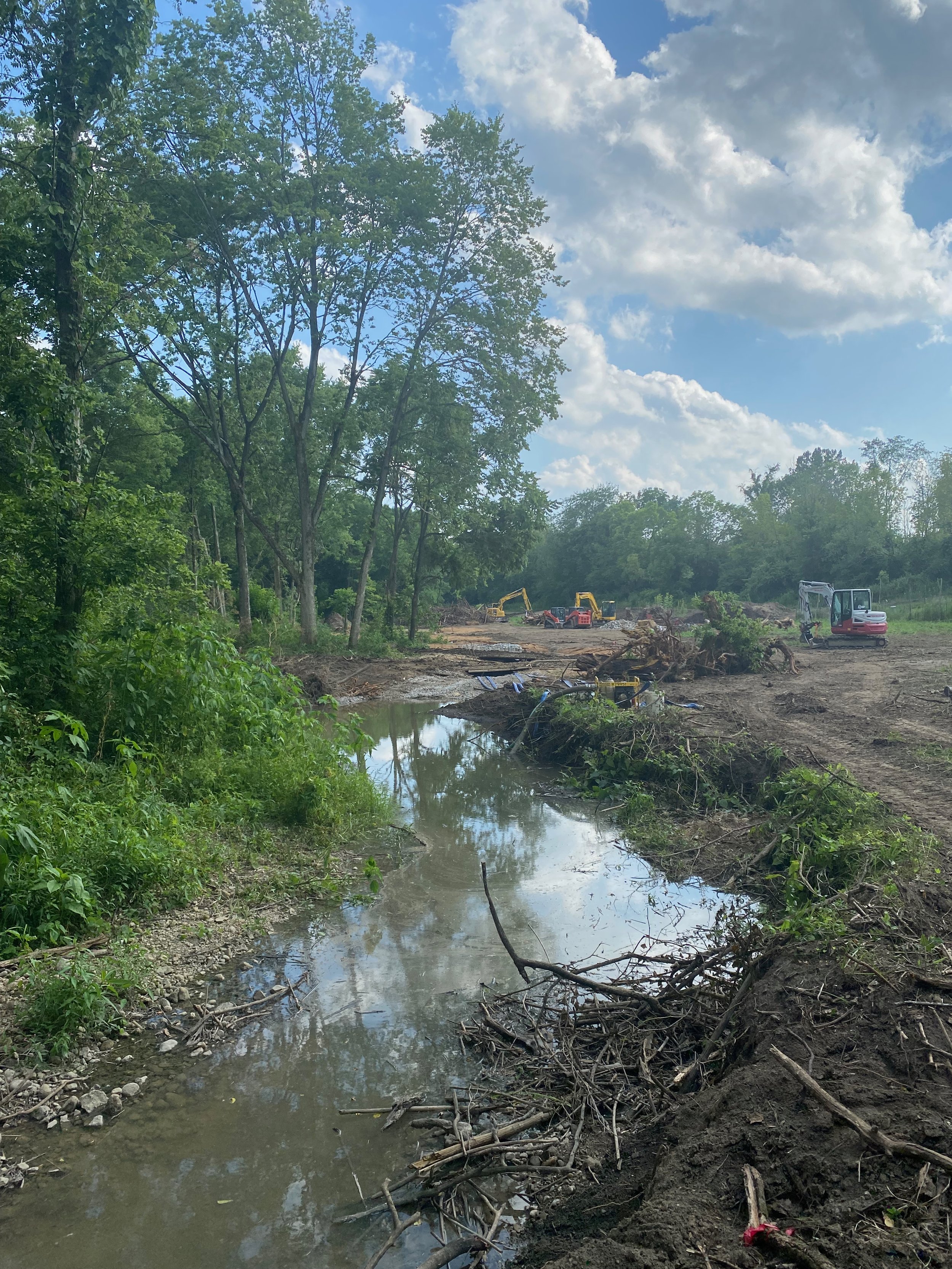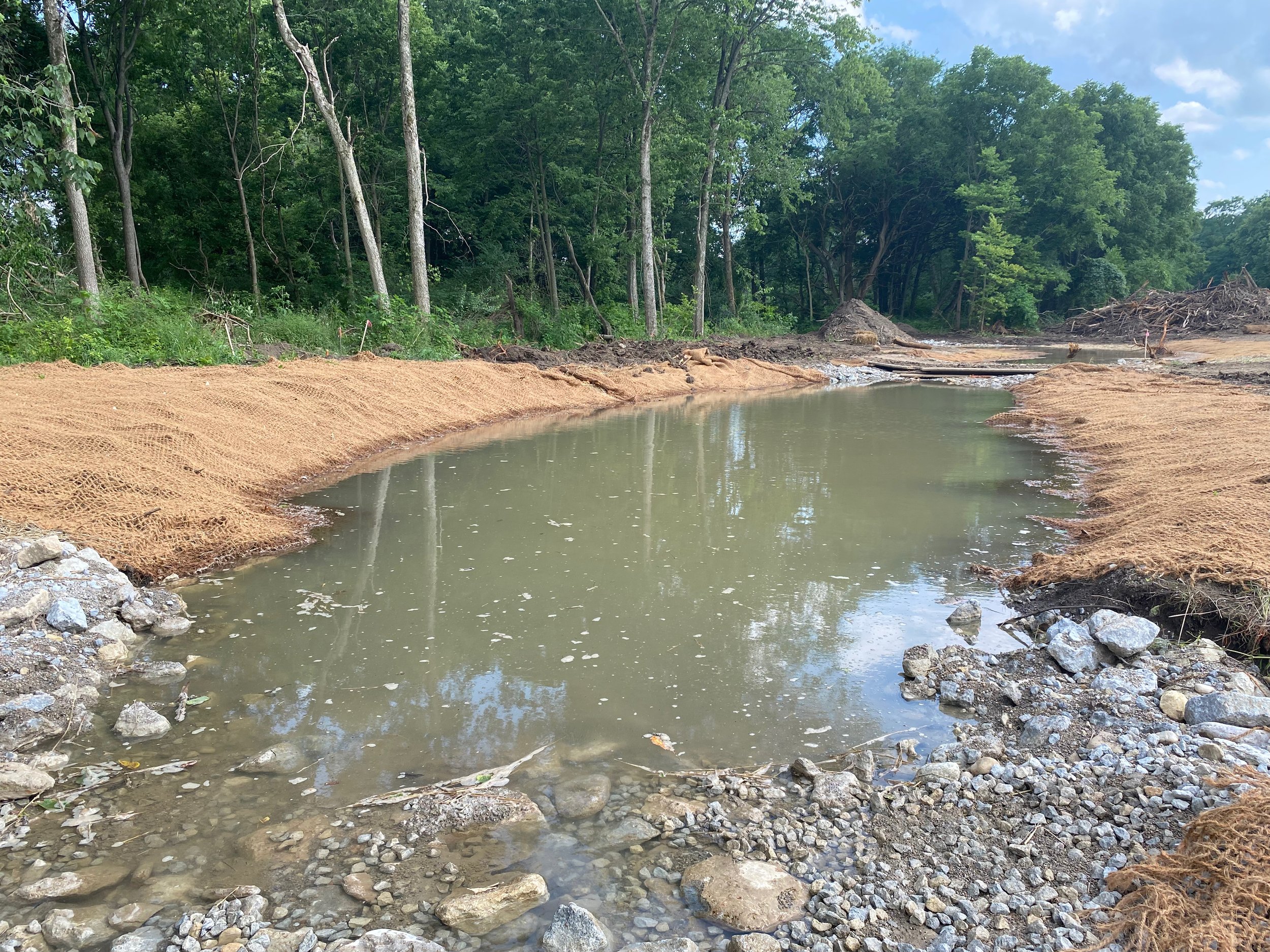Reforesting Agraria: An Interview with The Nature Conservancy’s Devin Schenk
Construction on the Jacoby Creek restoration in early August. Photo credit: Dennie Eagleson for Agraria
By Megan Bachman
It’s August on Agraria, and The Nature Conservancy is in its third month of work on the Jacoby Creek restoration project, a 10-year, $2 million project to transform our property by re-meandering streams, restoring wetlands and reforesting 60 acres.
Already the landscape is taking on new dimensions as trees come down, earth is moved and water is rerouted. By the end of the year, initial construction will be complete, and the focus will shift to planting 30,000 native trees, shrubs, forbs and grasses in an area that will serve as habitat and a food forest.
As the restoration got underway, I spoke with Devin Schenk, The Nature Conservancy in Ohio’s Mitigation Program Manager. Schenk manages the Ohio Stream and Wetland In-Lieu Fee Mitigation Program for The Nature Conservancy (TNC), overseeing a multi-million dollar fund to improve streams and wetlands across the state. Agraria’s restoration project was funded from that pool.
Schenk shared that TNC was initially approached by The Tecumseh Land Trust, a farmland preservation group based in Yellow Springs, about rehabilitating the property, which had been intensively farmed for decades. TNC’s funds helped secure a Tecumseh Land Trust conservation easement on Agraria, which was essential for our nonprofit to afford the purchase. Planning for the restoration got underway soon after, in 2017. After construction and planting, TNC will monitor the site for close to a decade.
Also participating in the restoration are Baltimore, M.D.-based engineering firm Biohabitats, which did the design, and Environmental Remediation Contractor of Columbus, Ohio, which is completing the construction.
The interview has been edited for length.
Devin Schenk, The Nature Conservancy in Ohio’s Mitigation Program Manager, is overseeing the Jacoby Creek restoration project. Photo Credit: David Ike for The Nature Conservancy
Bachman (Agraria): Can you share a little bit about your background? How did you get into this work?
Schenk (TNC): I am an ecologist and an attorney by training. In undergrad, I first started taking ecology classes and got fascinated with the idea of how interconnected the world is. I learned about the idea of restoration ecology, how through stewardship and deliberative action, we can heal disturbed ecosystems. It’s a very hopeful practice, restoration ecology. You’re not only planting trees but you’re looking to develop forests. You’re not only digging a wetland, but you’re creating an interconnected watershed, where plants and water and soil all work together.
Bachman (Agraria): You must get a lot of proposals. What interested The Nature Conservancy in this particular project? Why did we get selected?
Schenk (TNC): [This project] is a key piece to a much bigger effort. It’s not just repairing that stream, but it’s tying up to our Ohio goals for The Nature Conservancy — and the nation and worldwide — where we’re attempting to protect and preserve millions of acres.
Our focus in Ohio is in freshwater, biodiversity, land protection, sustainable agriculture and climate change mitigation. [TNC] was started in the 1950s with the idea of protecting the habitat for native species. We kept people out of it. The organization has evolved to realize that humans have to be a part of the calculus for obtaining worldwide conservation. Many of our initiatives are focused on finding sustainable ways for people to eat and find water, where conservation and meeting basic human needs overlap and can actually benefit each other.
Bachman (Agraria): Can you explain the in-lieu fee mitigation funding mechanism? How does it work?
Schenk (TNC): Mitigation is a term that can be complicated to explain but it boils down to looking at a simple term of “no net loss.” Wetlands and streams in Ohio and in the United States are protected by laws and if anyone is going to damage them, they have to offset their impacts. In the case of streams and wetlands, the offset isn’t just a simple, “if you fill in an acre of wetland, you have to restore an acre of wetland.” There is a complicated analysis of the quality of that wetland and a realization in the law that a restored wetland isn’t the same as a natural wetland. It takes time. You have to restore more acreage to take the place of what’s being destroyed.
TNC’s first large-scale project as part of the Ohio Stream and Wetland In-Lieu Fee Mitigation Program, was on the Strait Creek in Brown County. Photo credit: Dana Ohman for TNC
In the recent past — it hasn’t been around earlier than the 1990s — it was required that the developer who destroyed a wetland, had to create a wetland. For a big box store, the wetland might be created behind their dumpster. They had a failure rate of over 60 percent. We started looking at other options, such as mitigation credits, to ensure that the offset is going to be successful. So instead of the developer building a wetland, they provide a fee to The Nature Conservancy.
TNC was interested in doing this work, but we wanted to make sure our involvement did not encourage development. So we aren’t approached until the Ohio EPA is ready to give that permit. For us, it’s a matter of where it happens. Our restoration projects have to be of higher quality. We aggregate the credit sales within a watershed, in this case the Little Miami, to fund larger projects, and locate them in exceptional areas. We are looking for good partnerships, good projects, and good opportunities for ecological lift.
Bachman (Agraria): So how many projects does our $2-million Jacoby Creek restoration represent? How many big box stores are we talking about?
Schenk (TNC): This would be more than 20 developments. It’s not just big box stores, but the Ohio Department of Transportation putting in a culvert, home developers, municipalities building a police station, for example. Any of those entities have to get a permit, and they need to theoretically show that they’ve tried to avoid [harming] the streams and the wetlands, and if they can’t, they minimize the harm. Development can happen without impacting our natural resources but most areas that were easy to develop were already done.
Bachman (Agraria): How many of these projects are going on right now? How many have you completed, how many are in process?
Schenk (TNC): Our program is very young. Jacoby will be our fifth project in Ohio. We have 35 projects in the planning stages. About 15 projects will be restored by the end of 2023.
Bachman (Agraria): How common are these projects on agricultural land? Are there particular challenges or opportunities that an agricultural project brings?
Schenk (TNC): A big thing here is the opportunity not just to offset, but to tie mitigation activities in with conservation opportunities and find a win-win. Usually you’re looking for high biodiversity and ecological quality, but in the mitigation program, we’re looking for distributed habitats. We can’t restore a city block but a site like Agraria was just perfect. It had a lot of streams, but they were all straightened and ditched. There were a lot of hydric soils in the low-lying fields and a lot of springs. That added to just a wonderful nonprofit organization.
The idea of focusing stream and wetland restoration work on agricultural areas is not new. Oftentimes, low lying areas — where a wetland would be — are the least productive. The soils make it hard for things to be grown unless the soil is tiled and ditched and heavily manipulated. The farmer can get compensation for not farming certain areas and the aquatic resources can be restored.
What’s unique in this instance is that we’re not just restoring the streams and wetland footprint, we’re also restoring the buffer around those to a really robust levels and bringing it back to Midwest forested land. We’re not restoring this and walking away but there is a long–term management plan, there are endowment funds to pay for long-term protection and management of the natural areas. The other part is the two-tired buffer approach. The extended buffer is a place where Agraria can practice some management and harvest from it. That to my knowledge have never been done before.
Bachman (Agraria): Can you share anything unique or interesting about the design of the restoration?
Schenk (TNC): It’s really interesting to walk on a piece of land and imagine the human history there and as a detective try to figure out what was done to get it to its state now, what was the state previously and how do we put those pieces back together.
This piece of property had some really impactful management. There are a lot of instances on the property where streams were moved, put underground. There were very few trees. We found a picture from 1969 there were like six trees on the property. Because of that, we see the groundwater is bubbling out of the ground on the property, while the stream still dries in the summer. For a groundwater-fed stream to not be perennial means that fish and macroinvertebrates that would ordinarily be on that stream year-round, have to find somewhere else to go or dry up and die.The big goal of this project is retention of water, restoring the aquifer below Agraria and re-establishing all of the waterways so that that stream runs year-round. We can’t necessarily predict that will happen, but that is the goal.
Research found that when the land was first cleared of forests, the streams dried up. The forest acts as a sponge, the soil is lush and deep, and rainwater slowly drains to the groundwater. When there aren’t any trees, rainwater hits the ground and dries off, especially when streams are straight and have no shade. With the restoration, not only are we planting 30,000 trees and restoring those 60 acres, we will be connecting the land and the water and the groundwater into one big system.
Bachman (Agraria): Will it improve water downstream, in the Little Miami River?
Schenk (TNC): In its past, [Jacoby Creek] was a detriment to the water quality of the Little Miami. We’re going to flip this around and it will be a benefit to the river system. It was not a year-round source of water for the Little Miami. It was a source of sediment, nutrient pollution and pesticides. All of that is going away, and instead it will be a refuge for wildlife, a place where clean water will flow out.
In July, fish darted through the newly created riffles on the new channel of the Jacoby Creek. Video credit: Amy Harper
Bachman (Agraria): Would you like to share any final thoughts about the restoration?
Schenk (TNC): When we look at restoration, there is always some disruption that happens to get the land back to where it had been. The trees that grew up where the farmer moved the stream are providing a service. We wanted to do the restoration in a way that keeps the best of the trees and retains the biology that exists there. Every tree is wonderful, but they are not legacy trees. When we are looking at restoration, we are looking at the long term. Those 30,000 plantings are going to turn into the legacy trees. Many of the trees are staying, and they will have a chance to seed out on the fields that are being restored. We call that voluntary reforestation. In the end, it will be a lush, wonderful forest.
For more information about the Jacoby Creek restoration, visit an earlier blog post here.






